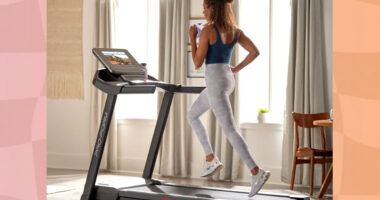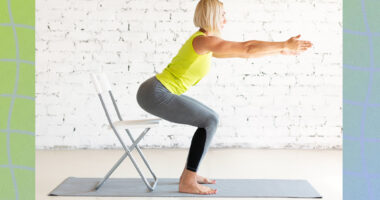
If you’re looking for stretches you can do anywhere at any time, it doesn’t get much better than the forward fold. Yes, we all know we should be following a regular stretching routine before and after a workout, and even on rest days if we truly want to improve flexibility. But sometimes you really just need that one stretch you can turn to when you want to loosen up and relieve tension during a busy day. Forward fold can be that for you.
The forward fold—also called a forward bend or fold-over stretch—is one of the best and easiest stretches to improve flexibility. It targets the back of the body and also relieves tension in your back and neck. And you can do it right next to your desk (no sitting on the floor required). Doesn’t get much easier than that.
What is the forward fold?
The forward fold is a stretch where you essentially fold your upper body over your legs. It’s actually a standard yoga pose (or asana)—“forward fold” in Sanskrit is Uttanasana—that’s included in a well-known series of poses called sun salutation. If you’ve ever taken a vinyasa-style yoga class, you’ve likely done plenty of forward folds.
The forward fold can be done standing or in a seated position. “When seated, you eliminate the contribution of the legs, so it is an easier form or a modification of a standing forward fold,” yoga instructor Bethany Lyons, owner and CEO of Lyons Den Power Yoga and Lyons Den Digital, tells SELF.
The benefits of the forward fold
In yoga, forward folds are used to help you ground down and get a solid foundation in your feet and legs, Lyons says. “They soothe the nervous system, they encourage some inward looking (introspection and inquiry), and they can be used as a warm-up and also as a cool down from more vigorous asanas.”
READ RELATED: Julia Bradbury makes final live TV appearance ahead of her mastectomy
“On the physical front, this pose stretches the hamstrings, hips, and calves,” Lyons says. You’ll also feel a gentle release in your neck and back. “A standing forward fold improves flexibility on the posterior [back] side of the body, which is so important for the amount of time we all tend to sit.”
It can also help improve your balance and proprioception, or your body’s ability to recognize and position itself in space. “The changing of visual cues and being upside down, along with changing your weight distribution, will improve the proprioception of the muscles around the joints of the the lower extremities,” Lyons says.
Who shouldn’t do the forward fold?
Forward fold is generally a safe and gentle stretch, but folding can exacerbate a back injury or spinal disc issue, Lyons says. Modifications that are gentler on the spine include bending the knees or switching to the seated version.
Also, putting your head below your heart, which happens in forward fold, may not be safe for people with high blood pressure. If you have any concerns about the safety of this pose for you, talk with your doctor or physical therapist before trying it.
How to add the forward fold to your routine
Lyons recommends doing forward fold any time during the weekday when you need a quick reset. In general, it’s a good idea to take standing and walking breaks throughout the day. When you do, add in a forward fold. “Start with bent knees and gradually start to straighten the legs to the degree they allow. Your hands can be on the floor for support or clasped behind your back,” Lyons says.
Source: SELF






